Magnolia Evergreen Varieties: Evergreen Tree Species & Their Care
Among the different evergreen varieties of magnolia trees and cultivars, the two most prevalent ones are Sweet Bay and Southern Magnolia
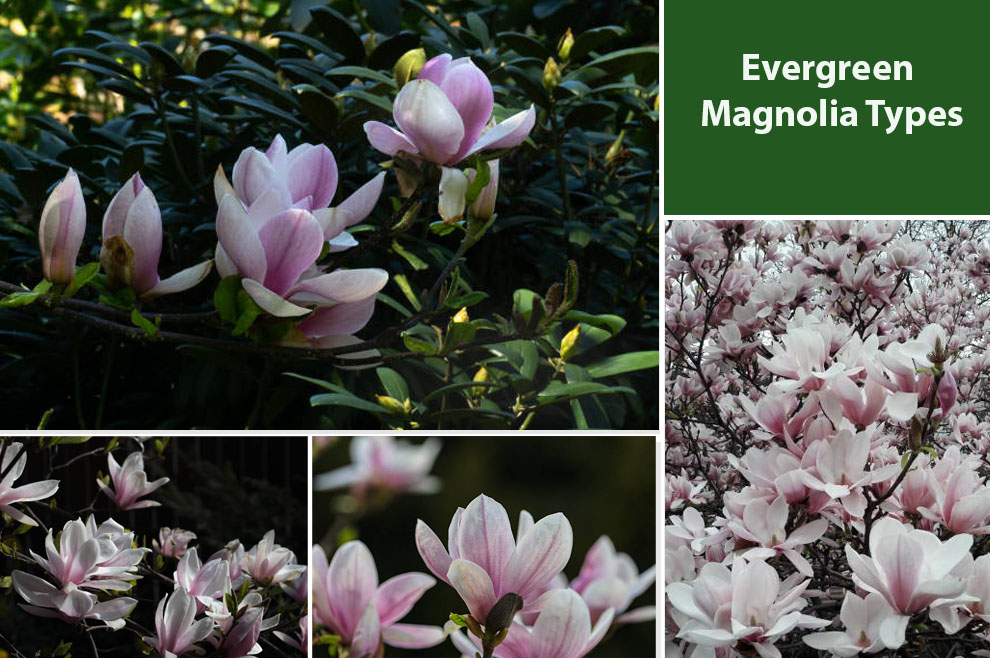
Magnolias are showy, elegant ornamental trees that may be evergreen or deciduous. Their evergreen variety is the perfect cherry on the cake in the dull winter moratoria. Hence, they are valued for their smooth, glossy, leathery foliage.
Multiple Magnolia species grow in the landscape. Of them, only two are evergreen. Below, we will discuss these two varieties in detail.
Common Magnolia Evergreen Varieties
- Southern Magnolia (Magnolia grandiflora)
- Sweet Bay Magnolia (Magnolia virginiana)
Typically, there are around one-hundred and twenty-five magnolia species, prevalently going as deciduous, evergreen, or semi-evergreen. Their green, lustrous leaves are the distinctive feature with appealing reddish fuzzy, silver, or green underside.
Amongst them, the leafy evergreen varieties retain their color around the year. Even though not every specie is suitable for all zones, most Magnolias are adaptable and thrive in warm to temperate zones.
Southern Magnolia or Magnolia grandiflora is the more common of the two evergreen magnolia species.. Grown across USDA hardiness zones Six A through Ten A, this specie has large, shiny foliage with cup-shaped flowers.
Sweet Bay or the Magnolia virginiana is a semi-evergreen variety that grows in USDA zones Five A through Nine A, where they retain oblong, glossy leaves around the year at the range’s warmer end.
Beyond this, several evergreen cultivars are bred to grow in every kind of yard, but it is not easy to grow these visually delightful Magnolia trees. They tend to overpower the landscape if you do not grow them in the correct location for magnolia.
Southern Magnolia (Magnolia grandiflora)
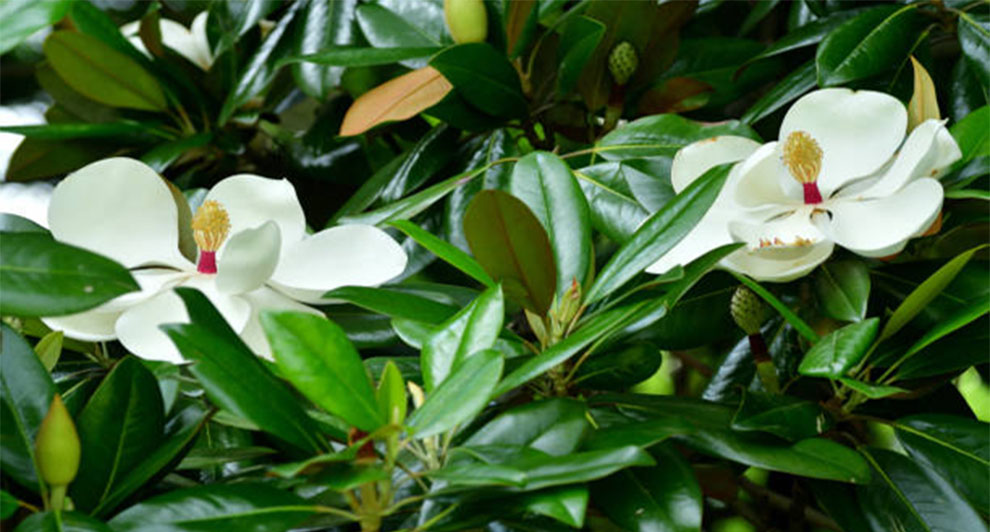
These are adaptable, beautiful evergreen magnolia types popular for their fragrant, large, white flowers and glossy, dark green leaves growing on the conical crown. Remarkably flexible and bred for its ornamental appeal, the Southern Magnolia grows beyond the South, too, in the Pacific Northwest.
It has a shallow root system and a dense canopy. The tree demands a vast space and requires frequent mulching to prevent soil erosion. So, it is not one of the ideal types of evergreen magnolia trees if you wish to cultivate anything underneath it.
Botanists recommend planting them in early fall or late spring, and they take around one to two decades to grow their full size. Its fall fruit is a lovely attraction for the birds in your landscape.
How To Care For Evergreen Southern Magnolia?
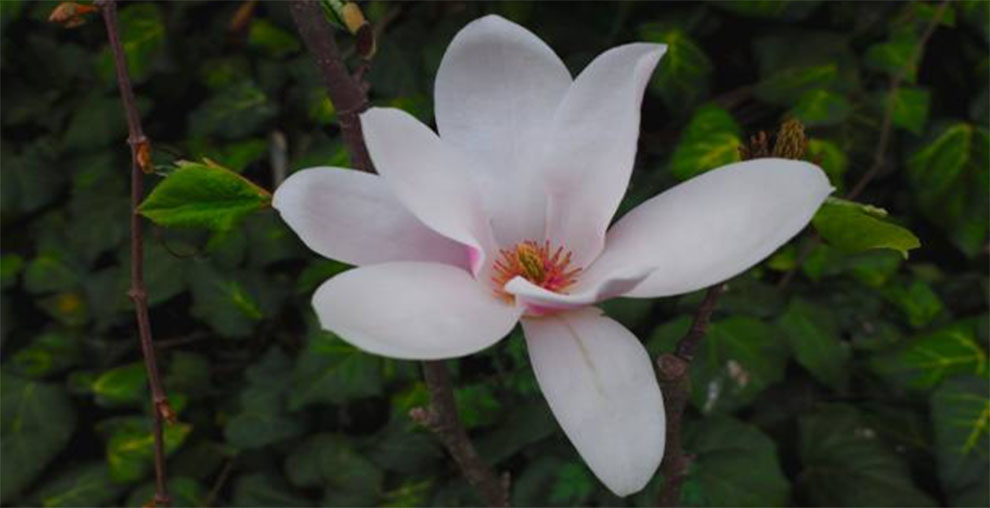
Southern Magnolia is an attractive, easy-to-grow specimen tree, provided that you grow them in a location shielded from the strong winds and there is ample room for them to grow. Also, before planting them, we recommend reading through the growing conditions to avoid making mistakes.
A. Planting Site
These magnolia evergreen varieties are cold hardy. You can plant them in the ground in a hole deep enough to accommodate the root ball. It should be twice the pot’s original size allowing roots to flourish. Typically, people prefer planting them as privacy screens or for defining the property lines. Since they have a messy leaf habit in the fall and during the spring, they are not the best lawn inclusion.
But, you can grow them in an ornamental bed, implying you use the thick debris can as the organic mulching material.
B. When to plant?
You can plant container-grown trees any time of the year. However, avoid it when the summer heat is sharp. The evergreen magnolia tree varieties, burlapped and balled, are transplanted between August and October.
In these species, transplant shock is a prominent phenomenon. So, do not worry if the tree sheds massively during the first growing season.
C. Soil
Even though the well-drained, moist soil works best for Southern Magnolia, it does the best in various conditions. But, they thrive in USDA hardiness zones six through ten, implying you can cultivate this variety in almost half the nation. But, it is best to opt for the site with sandy, loamy, or deep soil, which is at least acidic or has at least a neutral pH.
D. Sun
If you seek healthy Southern Magnolia with a good variety of spring flowers, you must plant them in full sun, but the plant can also grow in partial shade, provided it receives four hours of unfiltered, direct sunlight during the day.
E. Water
Southern evergreen magnolia species are fuss-free. People residing in the North should ensure that the plant is well-protected from the winter sun. Its root system is wide-spreading and shallow. Hence, offer it ample irrigation sans leaving the soil wet. If the root is well-drained and moist, the plant depicts drought tolerance.
When you plant these magnolia evergreen varieties, water them weekly till maturity. Once the tree establishes, its watering frequency will depend on the regional rainfall and soil drainage. If you water less or excessively, the leaves might turn yellow. Mulching around the planting site can be a good idea, sans letting the mulch touch the tree’s trunk.
F. Temperature
Extreme temperature is not ideal for magnolia trees. Temperature below 20 to -10° F can potentially harm the plant. Moreover, even a light frost tends to damage the seedlings.
G. Fertilizer
These evergreen magnolia types enjoy fertilizing at least three times a year – fall, summer, and spring. It helps the plant to trigger new growth. In the fifth or the fourth year, unless the tree is in infertile soil, its sprawling roots can find the requisite nutrients.
Sweet Bay (Magnolia virginiana)
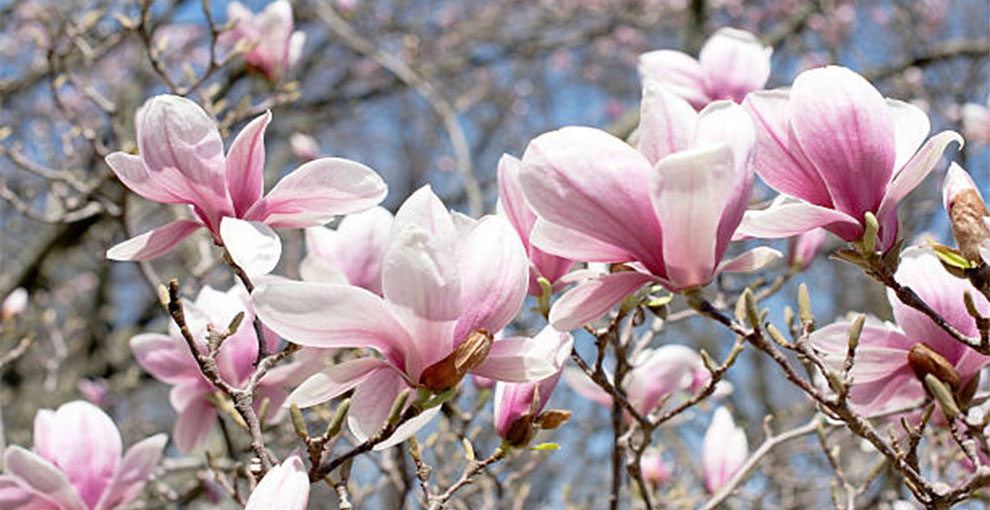
Following the reports by North Carolina State University Cooperative Extension Service, the Sweet Bay Magnolias are not as prominent as the Southern magnolia, given their smaller flowers. However, today several hybrids and cultivars possess good cold tolerance and improved blooming in this variety as well.
For instance, Henry Hicks’ has a twenty-five feet mature height with the same glossy green leaves as the standard variety. University of Florida IFAS Extension suggests that Henry Hicks are the only real types of evergreen magnolia trees that retain their leaves around the year.
Native to the South Eastern United States along the Atlantic coast to New York, the Sweet Bay Magnolias are also called the Swamp Bay Magnolia. They may be deciduous or evergreen, depending on the climate where they grow. The deciduous magnolia variety tends to shed its leaves in winter.
These trees grow between fifteen to twenty feet tall and may show as a rounded, spreading crown or an open, multi-stemmed, suckering, shorter shrub. If it grows farther in the Southern United States, it appears to be more tree-like, up to sixty feet tall.
How To Care for Sweet Bay Magnolia?
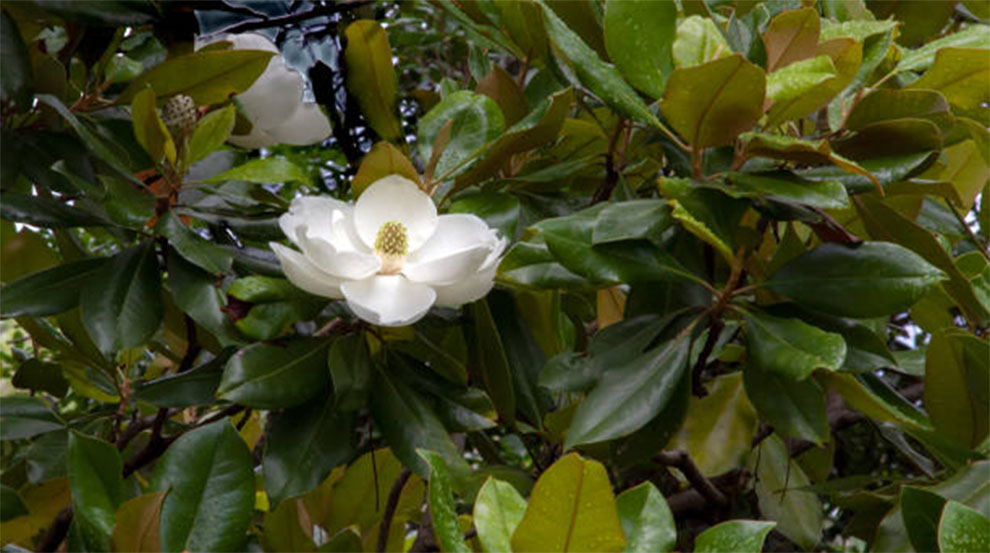
Magnolia trees are easy to care for. So are these evergreen magnolia tree varieties, pretty easy to grow. However, they are not a plant-it-and-forget specie. These Magnolias demand occasional pruning, annual feeding, and protection from pests. Regardless, their beautiful spring blossoms make them excellent landscape specimens, especially in their damp surrounding, where only a few trees thrive.
A. Sun
Fortunately, they are not very picky about the light they receive and thrive in both partial shade and full sun. Like several other flowering varieties, the more sun they get, the higher the probability of yielding plenty of blooms. Ideally, a good six to eight hours of daily sun can do wonders for these Magnolia varieties.
B. Soil
These magnolia evergreen varieties prefer rich, moist soil full of organic matter. Unlike the other Magnolia tree species, they will thrive in boggy, wet soil. They can even tolerate soils that are mainly clay. But, Sweet bay loves acidic soil with a pH between 5.5 and 6.5.
At any time, if you see your tree leaves becoming yellow, it indicates that the soil is too alkaline, and you must rectify it immediately.
C. Water
These trees cherish water. Hence, water deeply till they attain maturity. After the tree matures, water it only as necessary, ensuring that the soil does not stay dry for a long time. During warmer weather, the plant might seek additional watering.
D. Temperature and Humidity
Sweet Bay Magnolia has no specific humidity or temperature requirements, provided you grow them in the ideal hardiness zones. However, the plants grow smaller in cooler temperatures with a shrubby shape and size.
E. Fertilizer
Before you fertilize these evergreen magnolia species, perform a soil assessment test, and fertilize the tree only if it has a soil deficiency. Fertilizing because you think you must or using an unprescribed fertilizer can result in a fertilizer burn on these species. To avoid such situations, you can opt for a slow-release, organic magnolia fertilizers.
Related: Magnolia trees vs. bushes | Why are my magnolia trees dying?
Evergreen Magnolia Cultivars and Hybrids
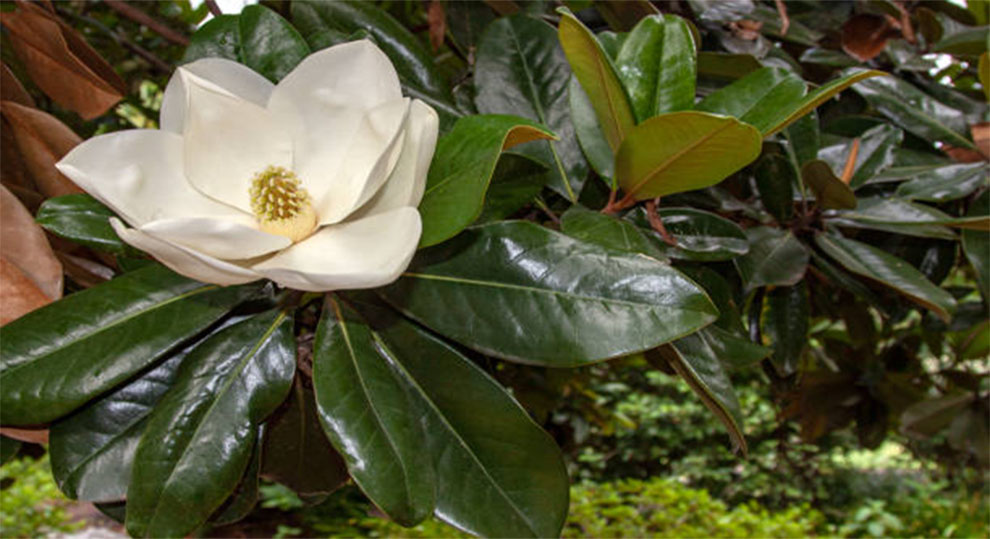
There are several Sweet Bay and Southern Magnolia cultivars. Some of them are hybrids. Here, we will enlist a few of them:
A. Northern Belle
It is a reliably evergreen Sweet Bay cultivar that grows across Zone 4. These plants grow between twenty and twenty-five feet, even in the Northern regions.
B. Emerald Tower
These Sweet Bay cultivars grow up to twenty feet and have glossy green foliage. These magnolia evergreen varieties thrive the best in zone 4.
C. Little Gem
It is an award-winning Southern Magnolia cultivar that is ideal for gardeners seeking a dwarf Magnolia variety. As one of the short varieties, it mainly grows as a shrub and does not grow over twenty-five feet. Even though its flowers and leaves are small, they are beautiful, and the tree blooms right from a young age.
D. Henry Hicks
It is a large Sweet Bay cultivar that grows as much as forty feet tall. It has a columnar growth habit and is evergreen into the USDA hardiness zone five.
E. Edith Bogue
Another Southern Magnolia cultivar, Edith Bogue, is one of the most cold-hardy varieties that grow denser and tighter as it ages. It has a pyramidal form and grows up to thirty feet tall.
F. Santa Rosa
The plant has the largest leaves of any of the evergreen magnolia species in the cultivar category. It is a Sweet Bay cultivar with a spreading habit. Santa Rosa thrives in USDA hardiness zones six through nine and grows up to twenty-five tall with an almost equal (around twenty-feet) spread.
G. Hasse Magnolia
It is a Southern Magnolia cultivar with a columnar, tight form. Hasse is the suitable pick for people with a smaller yard or garden, and gardeners usually grow it in rows as a privacy screen. These plants grow up to forty feet.
H. Keltyk
It is a Sweet bay Cultivar with a more compact habit with smaller leaves and is evergreen across its range. The plant grows up to twenty-five feet and is easy to keep small for use as a patio container tree.
Related: Magnolia Lifespan | Magnolia Growth Rate | Pruning Magnolia Trees
Frequently Asked Questions
Ques 1. Is there a small evergreen magnolia?
Ans. Little Gem Magnolia is a dwarf Southern Magnolia cultivar.
Ques 2. Which Magnolia blooms the longest?
Ans. Magnolia grandiflora Little Gem, or the Little Gem Magnolia, has a long bloom period of six months. It yields beautiful, large white flowers.
Summing up…
So, this is all about evergreen magnolia types. These can be a good pick if you want the glossy green texture in your environment all year round.
